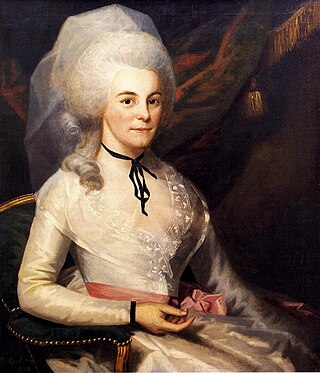Related Research Articles

William Cowper was an English poet and Anglican hymnwriter.

Anna Seward was an English Romantic poet, often called the Swan of Lichfield. She benefited from her father's progressive views on female education.

William Hayley was an English writer, best known as the biographer of his friend William Cowper.
Henry Edward Yelverton, 19th Baron Grey de Ruthyn was a British peer. He was a tenant and sometime friend of Lord Byron.

Anne-Thérèse de Marguenat de Courcelles, who on her marriage became Madame de Lambert, Marquise de Saint-Bris, and is generally known as the Marquise de Lambert, was a French writer and salonnière.

Matthew Wren was an influential English clergyman, bishop and scholar.
Richard Polwhele was a Cornish clergyman, poet and historian of Cornwall and Devon.

Elizabeth Hamilton, also called Eliza or Betsey, was an American socialite and philanthropist. She was the wife of American Founding Father Alexander Hamilton and was a passionate champion and defender of Hamilton's work and efforts in the American Revolution and the founding of the United States.

Angelica Church was an American socialite. She was the eldest daughter of Continental Army General Philip Schuyler, and a sister of Elizabeth Schuyler Hamilton and sister-in-law of Alexander Hamilton.

Louis Lambert is an 1832 novel by French novelist and playwright Honoré de Balzac (1799–1850), included in the Études philosophiques section of his novel sequence La Comédie humaine. Set mostly in a school at Vendôme, it examines the life and theories of a boy genius fascinated by the Swedish philosopher Emanuel Swedenborg (1688–1772).

William Seward was an English man of letters, known for his collections of anecdotes. he was closely acquainted in London with Samuel Johnson, the Thrales and the Burneys.
Thomas Park (1759–1834) was an English antiquary and bibliographer, also known as a literary editor.

Margaret Harries Wilson was an English poet, playwright, lyricist, writer and editor. She is considered one of the first female biographers.
The known works of Anna Seward include the following:

Honora Edgeworth was an eighteenth-century English writer, mainly known for her associations with literary figures of the day particularly Anna Seward and the Lunar Society, and for her work on children's education. Sneyd was born in Bath in 1751, and following the death of her mother in 1756 was raised by Canon Thomas Seward and his wife Elizabeth in Lichfield, Staffordshire until she returned to her father's house in 1771. There, she formed a close friendship with their daughter, Anna Seward. Having had a romantic engagement to John André and having declined the hand of Thomas Day, she married Richard Edgeworth as his second wife in 1773, living on the family estate in Ireland till 1776. There she helped raise his children from his first marriage, including Maria Edgeworth, and two children of her own. Returning to England she fell ill with tuberculosis, which was incurable, dying at Weston in Staffordshire in 1780. She is the subject of a number of Anna Seward's poems, and with her husband developed concepts of childhood education, resulting in a series of books, such as Practical Education, based on her observations of the Edgeworth children. She is known for her stand on women's rights through her vigorous rejection of the proposal by Day, in which she outlined her views on equality in marriage.
John Warner (1736–1800) was an English cleric and classical scholar.

Margarita "Peggy" Schuyler Van Rensselaer was the third daughter of Continental Army General Philip Schuyler. She was the wife of Stephen Van Rensselaer III, sister of Angelica Schuyler Church, Philip Jeremiah Schuyler, and Elizabeth Schuyler Hamilton, and sister-in-law of John Barker Church and Alexander Hamilton.
Susan, Viscountess Pellew was the wife of Edward Pellew, 1st Viscount Exmouth.
John Johnson was a Church of England clergyman, poet, and editor, a cousin and friend of William Cowper, who lived with Johnson in his declining years.

Frances Maria Cecilia Cowper, sometimes known as Maria Frances, was a religious poet and part of the Madan-Maitland literary coterie.
References
- ↑ Blain, Virginia (1990). The Feminist Companion to Literature in English: Women Writers from the Middle Ages to the Present. Batsford. p. 503. ISBN 0713458488.
- ↑ Lisa Gee. "A Museum of Relationships: The correspondence of William Hayley (1745-1820)" . Retrieved 14 May 2021.
- ↑ Lisa Gee. "The correspondence of William Hayley" . Retrieved 14 May 2021.
- ↑ Gee, Lisa. "Eliza Hayley – the portrait mystery". Youtube. Retrieved 14 May 2021.
- ↑ John Johnson (1823). "Memoirs of the Life and Writings of William Hayley, Esq. The Friend and Biographer of Cowper". Google Books. London. S. and R. Bentley. Retrieved 14 May 2021.
- 1 2 Lisa Gee (2019). "A poet, his wife, and "the ugliest of all possible kept mistresses"". Cambridge University Museums: Collections in Action. Cambridge University Press. Retrieved 14 May 2021.
- ↑ Anna Seward (1811). "Letters of Anna Seward". Archibald Constable. Retrieved 14 May 2021.
- ↑ Vivienne W. Painting (2004). "ODNB: Hayley, William (1745–1820)" . Oxford Dictionary of National Biography (online ed.). Oxford University Press. doi:10.1093/ref:odnb/12769. ISBN 978-0-19-861412-8 . Retrieved 14 May 2021.(Subscription or UK public library membership required.)
- ↑ John Johnson (1823). "Memoirs of the Life and Writings of William Hayley, Esq. The Friend and Biographer of Cowper". London. S. and R. Bentley. Retrieved 14 May 2021.
- ↑ Sylvanus Urban (1797). "The Gentleman's Magazine, volume 82". London. John Nichols. Retrieved 14 May 2021.
- ↑ Blanch-Serrat, Francesca (2 December 2019). ""I mourn their nature, but admire their art": Anna Seward's Assertion of Critical Authority in Maturity and Old Age". ES Review. Spanish Journal of English Studies (40): 11–31. doi: 10.24197/ersjes.40.2019.11-31 . S2CID 213829196 . Retrieved 14 May 2021.